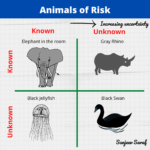BLEVE stands for Boiling Liquid Expanding Vapor Explosion
If a tank containing liquid is subjected to external fire, the heat from the fire lead to boiling of the liquid. This in turn leads to increased pressure in the tank. This “boiling” liquid and “expanding” vapor may increase the pressure significantly and cause the tank to rupture. If the released liquid is flammable , it can catch on fire resulting in a fire and explosion.
The following video demonstrates the BLEVE phenomenon:






9 Responses
Nice video. This is most important for emergency responders to be mindful of. Because there is no real warning and it seems that things are stable until the BLEVE occurs, people will have a false sense of security and may even approach closer to the tank even though the fire isn’t out yet. I have seen similar videos with actual footage from BLEVE’s. One video that comes to mind had a fireman applying water spray above a tank trailer, suspended by a fire truck ladder. The video camera was nearby, as well as police and passersby.
The definition implies that the liquid is in a closed container but some of the worst BLEVE’s have been with light liquid hydrocarbons released to the ground and expanding very rapidly. When the expanding vapor reaches an ignition source the explosion happens.
The definition of BLEVE is such that it does not require a fire to be present. There have been cases where rail tankers have BLEVE’d sitting on a siding. The tank car had been involved in a derailment and the circumferencial weld on the head had been damaged. Over a period of months the damage turned to a crack which eventially caused the head to separate from the tank and rocket down the rail line. The same phenomenon has been seen with steam drums. The only criterion is that the liquid be above its normal boiling point. The vapour that is generated when the container fails provides the energy to propel the vessel or pieces of the vessel away from the original tank location.
The mechanism given for the pool fire-induced BLEVE can be further elaborated. The fire will cause the pressure in the vessel to rise to the point where the relief valve activates. This will relieve the pressure and provide cooling to the liquid, through vaporization. As the liquid is vented from the vessel the tank wall above the liquid level loses the cooling properties of the liquid and starts to heat due to the lower cooling capacity of the vapour phase. This heating weakens the vessel sufficiently to allow it to fail at a pressure at or below the relieving pressure of the vessel. Providing a relief system will not prevent a BLEVE and will even increase the chance of BLEVE by removing the liquid cooling capacity.
That begs the question of how to avoid a BLEVE. There are three possible ways:
1. Put out the fire!
2. Provide external cooling in the form of fixed deluge (preferred) or water spray from hose lines. Emergency Responders should set the hose lines and then evacuate to a distance of at least one kilometer from the fire.
3. Maintain the liquid level in the vessel by pumping in more of the material that is burning or a non-flammable material. Water is the preferred liquid for the latter if it can be pumped at a high enough pressure to overcome the pressure head in the tank.
These responses relate only to pool fires, since a BLEVE can also be induced by a jet fire on the vapour space of the tank. Under such conditions there is little heat transfer to the liquid and the relief valve may not activate prior to the metal weakening to the point of failure. These BLEVEs must be prevented by ensuring that failure of a connection at the top of the tank will not impinge on the vapour space.
There are many other design aspects that can prevent a BLEVE or mitigate the consequences, depending on the specific circumstances.
Here are some other BLEVE related videos on Youtube:
http://www.youtube.com/watch?v=lJt7CkqGcS8
http://www.youtube.com/watch?v=Xf3WKTwHpIU
http://www.youtube.com/watch?v=xn_GSxTDnyc
http://www.youtube.com/watch?v=Ucs5qrR5X0w
http://www.youtube.com/watch?v=9jnGsZ0VP0c
I am looking for statistics on BLEVE accidents in Rail Cars. Can anyone help?
I am a retired police officer and recently a question came up regarding gasoline tankers and the ability of firearms (Handguns or Rifles) to penetrate the gasoline tank causing a BLEVE. I Goggled BLEVE and found your web-site. Reading the above definitions of BLEVE and responses, it doesn’t seem that the scenario of penetrating a tank with a bullet would cause a BLEVE since there would be no boiling of the gasoline. I would also think that gasoline tankers would have tanks that were thick enough to prevent penetration from most bullets. If anyone would have the technical knowledge to answer my question, I’d appreciate it. If the information is classified, I understand. Thanks.
Jim…You are right. If a bullet were to hit a gasoline tanker it would not lead to a BLEVE. Feel free to contact me if you have any questions.
a) LPG gas cylinder wall thickeness may be upto about 15 cm. Will a bullet penetrate and from what range, it is a question.
b) for combustion and explosion, there has to be a correct Volumetric ratio of Gas and Oxygen.
Suppose If a Tank is even ruptured by bullet and
the heat created is also sufficient, the LPG
cannot just get heated up for BLEVE Phenomenon instantly.
Yes, due to the rupture, the leaking Liquified will start to change into gas, will mix with air and at correct ration will ignite if source of ignition is present at the site.
The BLEVE will follow from then on!!